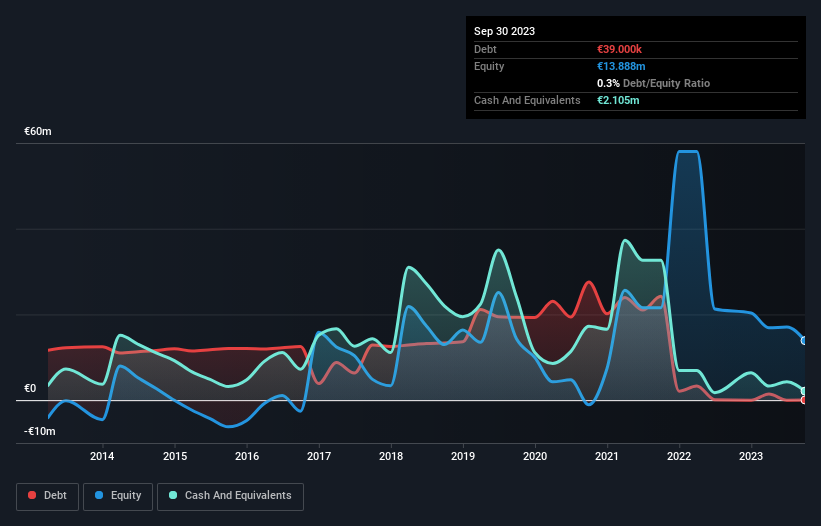We're Keeping An Eye On Biofrontera's (ETR:B8F) Cash Burn Rate

We can readily understand why investors are attracted to unprofitable companies. For example, although software-as-a-service business Salesforce.com lost money for years while it grew recurring revenue, if you held shares since 2005, you'd have done very well indeed. Having said that, unprofitable companies are risky because they could potentially burn through all their cash and become distressed.
Given this risk, we thought we'd take a look at whether Biofrontera (ETR:B8F) shareholders should be worried about its cash burn. In this report, we will consider the company's annual negative free cash flow, henceforth referring to it as the 'cash burn'. First, we'll determine its cash runway by comparing its cash burn with its cash reserves.
See our latest analysis for Biofrontera
How Long Is Biofrontera's Cash Runway?
A company's cash runway is calculated by dividing its cash hoard by its cash burn. Biofrontera has such a small amount of debt that we'll set it aside, and focus on the €2.1m in cash it held at September 2023. In the last year, its cash burn was €3.8m. Therefore, from September 2023 it had roughly 7 months of cash runway. That's quite a short cash runway, indicating the company must either reduce its annual cash burn or replenish its cash. You can see how its cash balance has changed over time in the image below.

Is Biofrontera's Revenue Growing?
We're hesitant to extrapolate on the recent trend to assess its cash burn, because Biofrontera actually had positive free cash flow last year, so operating revenue growth is probably our best bet to measure, right now. Unfortunately, the last year has been a disappointment, with operating revenue dropping 11% during the period. Of course, we've only taken a quick look at the stock's growth metrics, here. This graph of historic earnings and revenue shows how Biofrontera is building its business over time.
Can Biofrontera Raise More Cash Easily?
Since its revenue growth is moving in the wrong direction, Biofrontera shareholders may wish to think ahead to when the company may need to raise more cash. Generally speaking, a listed business can raise new cash through issuing shares or taking on debt. Commonly, a business will sell new shares in itself to raise cash and drive growth. By looking at a company's cash burn relative to its market capitalisation, we gain insight on how much shareholders would be diluted if the company needed to raise enough cash to cover another year's cash burn.
Biofrontera's cash burn of €3.8m is about 15% of its €25m market capitalisation. As a result, we'd venture that the company could raise more cash for growth without much trouble, albeit at the cost of some dilution.
Is Biofrontera's Cash Burn A Worry?
Even though its cash runway makes us a little nervous, we are compelled to mention that we thought Biofrontera's cash burn relative to its market cap was relatively promising. After looking at that range of measures, we think shareholders should be extremely attentive to how the company is using its cash, as the cash burn makes us uncomfortable. Taking a deeper dive, we've spotted 3 warning signs for Biofrontera you should be aware of, and 2 of them are concerning.
Of course, you might find a fantastic investment by looking elsewhere. So take a peek at this free list of interesting companies, and this list of stocks growth stocks (according to analyst forecasts)
Valuation is complex, but we're here to simplify it.
Discover if Biofrontera might be undervalued or overvalued with our detailed analysis, featuring fair value estimates, potential risks, dividends, insider trades, and its financial condition.
Access Free AnalysisHave feedback on this article? Concerned about the content? Get in touch with us directly. Alternatively, email editorial-team (at) simplywallst.com.
This article by Simply Wall St is general in nature. We provide commentary based on historical data and analyst forecasts only using an unbiased methodology and our articles are not intended to be financial advice. It does not constitute a recommendation to buy or sell any stock, and does not take account of your objectives, or your financial situation. We aim to bring you long-term focused analysis driven by fundamental data. Note that our analysis may not factor in the latest price-sensitive company announcements or qualitative material. Simply Wall St has no position in any stocks mentioned.
About XTRA:B8FK
Biofrontera
A biopharmaceutical company, engages in the research, development, and distribution of dermatological products in Germany, Spain, the United Kingdom, rest of Europe, the United States, and internationally.
Flawless balance sheet and slightly overvalued.
Market Insights
Community Narratives



